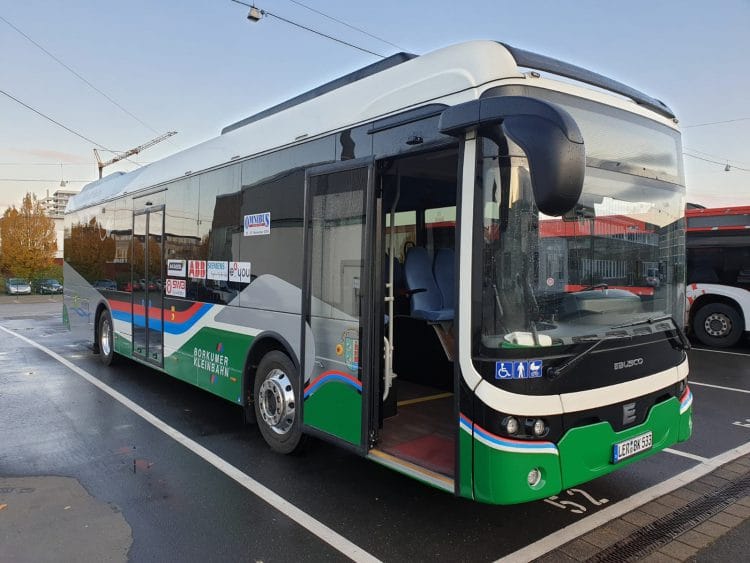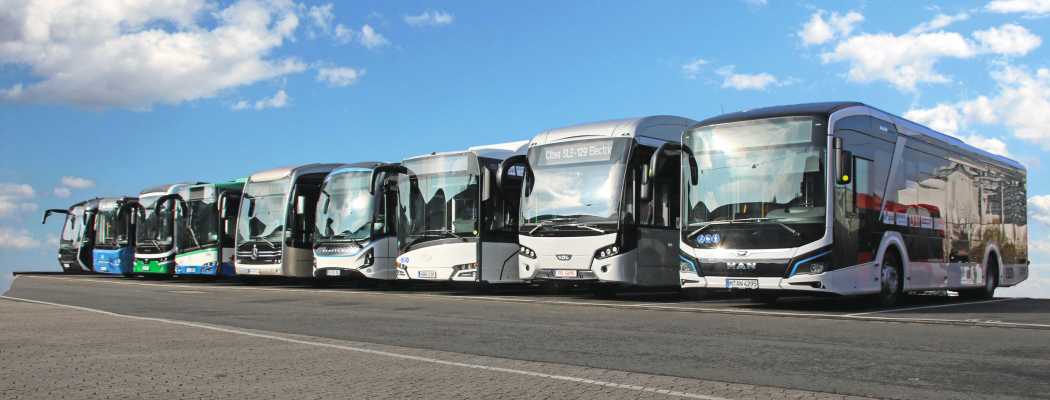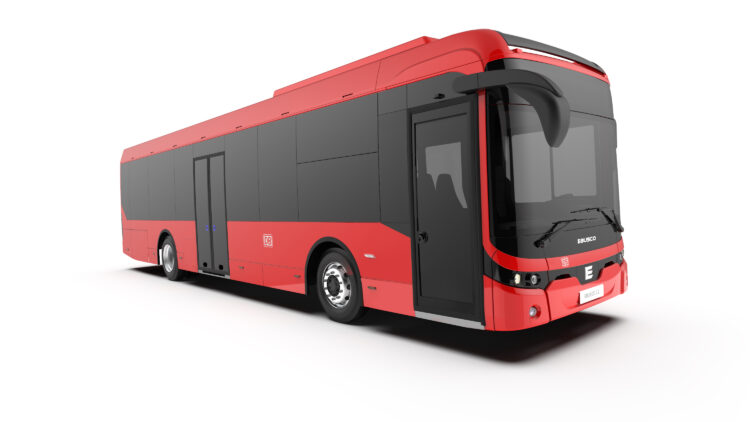Al vanaf onze oprichting geloven wij bij Ebusco in de combinatie van laag gewicht en hoge batterijcapaciteit. Daarmee kun je namelijk veel passagiers vervoeren en veel kilometers afleggen. Wat ons betreft de gouden formule! No doubt: 90 passagiers en > 350 km!
Recent heeft Omnibus (Duitsland) samen met journalisten uit heel Europa 9 bussen naast elkaar getest in Bonn en de feiten liegen er inderdaad niet om. Lees hier het volledige artikel, vertaald in het Engels:
For the third electric bus comparative test, the specialist journal “Omnibusspiegel” invited vehicle testers to Bonn from throughout Europe in the middle of November. And for the second time since 2016, 12 metre solos were tested, after articulated electric buses were tested the year before. Seven candidates – the who-is-who of the current electric bus scene – took part in the test. There was also an opportunity to drive two experimental vehicles from ZF and Voith.
Even the MAN Lion’s City E was included, which will not come onto the market until the second half of 2020 and is now in customer trials. Mercedes-Benz was also proud to present the eCitaro – its new public transport product. From France, there was the Heuliez GX337e, an exciting vehicle concept with an attractive design. Otherwise, there were the same manufacturers as in 2016 with their latest models: Ebusco with the 2.2., VDL with the Citea SLE 129 Electric and the Sileo S12 and the Solaris Urbino 12 electric.
The vehicles
This time, Ebusco brought the 2.2, of which four units were also supplied to SWB (where the electric bus comparative test took place) at the end of 2020. Some transport companies in Germany, for example MVG in Munich, are already using this long-range vehicle. The Ebusco 2.2 was the only one of the seven candidates to have lithium iron phosphate batteries (362 kWh). But in future, it will also be available with ABB pantographs.

The Solaris Urbino 12 electric was already fully equipped as a customer vehicle for Ettenhuber, including a pay booth with monitor, Mobileye 630 driver assistance system, two 18.5″ monitors, USB outlets in the side wall and fabric-covered STER seats. The Urbino articulated buses will also go to SWB at the end of 2020.
The Heuliez GX337e is an attractive vehicle with its large glazed wheelchair/buggy area and its elegant shapes. The French vehicle was the only candidate that did not have a heat pump or air conditioner, and only had a Valeo hybrid heater (20 kW fossil fuel, 23 kW electric). The NMC high-energy batteries of type Forsee ZEN 4 with 140 Wh/kg energy density do not need to be cooled or heated.
The Sileo S12 too was equipped with a 20/23 kW hybrid heater, but also had three extra Citysphere modules. At the customer’s request, there was no energy-intensive heat pump on the vehicle roof because the future operator wants maximum range with a fossil-fuel block heater and also did not want complicated air conditioning technology.
The Mercedes-Benz eCitaro was the identical vehicle from the busplaner Profi test in the 8/2019 issue. We will therefore not describe it in detail, and move directly to the MAN Lion’s City E, which all the participating journalists were excited to see for the first time in a test. However, busplaner has already driven this vehicle – in Munich in July (report in busplaner 7/2019).
The VDL Citea SLE 129 Electric was the only vehicle in the test to have Microvast lithium polymer batteries. They have very good fast-charging capabilities, and that is why the test bus also had charging rails on the roof for top-down charging. Its fossil-fuel block heater had been removed for the presentation at Busworld in Brussels, so it arrived in Bonn with “only” the Thermo King heat pump on the roof.
The route
The circular route beginning and ending at the SWB depot in Friesdorf was identical to the comparative test of 2018. The large loop included a section on the “wrong side” (as the local people affectionately call it) of the river Rhine. The climb to Rheinhöhe in the direction of Niederholtorf also included an incline of several percent where the solos had to prove their climbing capability. Each trip was 22.3 km, and included 28 stops.
The driving test
On the test route, the seven candidates soon showed their strengths and weaknesses. For example, the fast starting behaviour of the Heuliez was impressive – the power can be individually configured more in an electric bus than in a diesel bus – and also its good handling. So it is a good vehicle for the driver. On a hill, however, especially when starting, it is not so great. Positive aspects include roll and pitch, manoeuvrability, ride comfort and above all the responsiveness of the steering. But in terms of comfort, the French vehicle has much room for improvement. Shock absorption and suspension comfort are average at best. The high noise level in the vehicle is also a problem, caused by the badly-insulated drive system and the noisy front axle, but mainly by the creaking and squeaking bodywork.
There were also good and bad aspects in the Ebusco 2.2. It too received minus points in suspension and shock absorption comfort. Roll and pitch were not impressive. On the other hand, it had good steering, manoeuvrability, well-controlled braking characteristics despite the unresponsive pedal, and above all the powerful drive system. Like the auxiliary equipment, the drive system is also very quiet, but the overall result is much too noisy because of creaking bodywork, the loud noises when driving over uneven road surfaces, and the rumbling front axle. The Ventura Rapid Slider doors fit properly but amplify the noise made by the rest of the bodywork.
Sileo has been able to improve its old problems in the new model, but they have not been fully solved. The bodywork is much too loud, and the worst parts are the banging IBIS monitor and pay booth and door 1. The drive system is also very noisy. On the other hand, the German/Turkish vehicle drives well overall, and the ride comfort, steering and responsive brakes are particularly good. However, the mudflaps rub against the wheel when the bus is turned sharply – an unnecessary problem.
VDL and Solaris already have many years of experience of building electric buses, and they can use their experience to help with the configuration of the drive train and with noise management. But the models from the Netherlands and Poland also had negative points. In the Citea, noise was caused by air in the steering – probably an easy problem to solve. But the auxiliary equipment, underseat heaters and drive train were also very noisy. The starting behaviour and power development – especially on the hill – are not as good as they should be. Otherwise, however, the Dutch have been doing their homework: there are no problems with roll and pitch, manoeuvrability, ride comfort, suspension and shock absorption comfort, and the responsive brake. The resonance behaviour of the bodywork is now well under control.
This problem is not fully solved in the Urbino. But its biggest problem is the sometimes unpleasant whistling from the converters, especially at full power on the hill. Improvements are still necessary in the suspension and shock absorption. The main minus point, however, was the uncomfortable brake penal that was difficult to operate, needing much force. The bus therefore often came to a sudden and unpleasant stop. However, the Polish vehicle was a real “sports car” with acceleration of up to 1.2 m/s2 depending on load and driving conditions. It is fun to drive, and the drive system and chassis performance are good for almost all driving conditions.
The testers were excited to find out how the Lion’s City E would perform. The result: very good. It is clear that the Munich manufacturer knows how to build buses. We gave it the best score in many categories, and the quiet drive system was particularly impressive. Improvements are necessary in some areas: noise in the bodywork, power development on the hill, and braking to a standstill, which sometimes ended with a sudden jerk. We were unable to find the cause of an occasional, short hum, which might come from the air conditioning compressor connection, as in the first eCitaro prototype.
But even this was not enough for victory in the category of running characteristics. Because there was a clear winner: the Mercedes. We gave it the best scores in almost all categories. Only the activity of the drive system with the converters was louder at times. Very good: the rounded, fast starting behaviour. It was difficult to decide in this situation whether it would be possible to avoid the load side wind noise at door 1, which occurred on the Konrad Adenauer Bridge over the Rhine. Overall, however, the eCitaro showed its high quality in direct comparison with the competition.
Unladen weight
Weight is an important subject, and some manufacturers still have problems because they use too many GRP or ABS parts in the cladding. The Lion’s City (14.45 t), the eCitaro (14.25 t) and the Citea (14.7 t) were much too heavy. To be fair, the Citea used in the test had the winter package ordered by the Scandinavian customer, for example double glazing including the doors, and a snow-proof cover for the batteries. But the Urbino (13.9 t) and the GX337e (13.78 t) are no lightweights. The clear winners in this category were the Sileo S12 (13.0 t) and – thanks to the sandwich panel floor and plastic roof – the Ebusco 2.2 (13.04 t).
Static vehicle check
The static vehicle check produced a large number of results and there is no space in this report for all of them. We would therefore like to focus on a few interesting and central aspects. Generally, the build quality is good to very good. In the early years of electric buses, they had a “homemade” quality, but this is rare these days, especially among the famous manufacturers taking part in this comparative test. We mostly gave high scores for the quality of fittings and furnishings such as the floor covering and laying, seat quality, ease of cleaning or general workmanship. LED running lights are compulsory almost everywhere.
But there are differences: the Ebusco received only moderate scores for joins and painting or for the gap dimensions. Sharp edges are a problem in the cantilever fixings, and many parts are robust rather than attractive-looking. There is no storage in the driver’s cab – a problem which the Heuliez also has. And there is a real risk of injury from the platform – a sharp edge sticks out from the left of the driver’s seat. On the outside there was a large unused space at the rear on the right in the LE model. There is also wasted space without getting an extra seat at door 1 if a single-width door is ordered instead of a double-width door.
A closer look at the eCitaro shows many nice details, for example the fastening screws recessed in the plastic of the runners, protecting them even if the bottom of the vehicle hits the road – an idea taken from motorcycle crash pads. Or the sound-absorbing Taraflex coating on the wheel treads and platforms. Or the covers with rubber lip for the seat rails, making them extremely easy to clean. Also easy to clean is the eCitaro logo on and in the vehicle, which is no longer three-dimensional like older Mercedes models.
In Lion’s City E, the new sunshield is an interesting solution – it is designed as a flap on the A-column, and adds to the shading for the front and side windows. The indirect LED lighting in the passenger area is nice, and is available in different colours.
The Sileo S12 has heating for the front and corner windows and for the mirrors. The test vehicle had two charging connections above the front axle on the left and right. A small motor closes the unused connection automatically – a solutions that feels almost playful, like the tailgate that opens vertically upwards. The electric bus from Salzgitter has a compressor with air filter. This allows warm air from the interior to be used for the compressor, which has certain advantages and stops condensation forming on the inside.
A wide range of relatively eco-friendly fuels is available for the fossil-fuel Valeo block heater in the Solaris. It includes biodiesel and FT diesel, FAME and HVO, and methanol. The Citea in the “winter version” for the Scandinavian customer provides underfloor heating in the entrance areas and underseat heaters, which are not liked by all operators. The Kiel seats are fully fabric-covered so they are very pleasant even if the inside is cold. The RGB LED inside can create indirect light with different colours – a nice effect.
The workshop check
We and a few SWB mechanics also inspected each vehicle over the pit. The Ebusco and the Heuliez had HV cables that were laid untidily and sometimes unconventionally, the eCitaro had sometimes unprotected cable bunches, and the MAN had badly-positioned fossil-fuel heating that was possibly dangerous. The Citea also had a cooling pipe for steering fluid passing directly on the front of the bus. Otherwise it stands out because of its generally good build quality and tidy cable laying.
In the eCitaro the rear is not well designed, and the tow hook is not practical. The Sileo has an electric AVE connection with a service-friendly intermediate socket. Overall, the build quality is much better than the first models, which are currently in service in SWB.
Measurement of consumption
The most important part of an electric bus comparative test is the measurement of consumption. However, because the individual vehicle concepts are too different, it would not be possible to create a ranking of consumption. Instead, as in 2016 and 2018, we are only publishing the relative positions of the values achieved, taking account of the different heating types.
The test took place at low temperatures just above freezing, so a significant part of the energy was used for heating – as much as one to two thirds of the overall energy consumption. The vehicles were also kept heated for about 20 minutes between the individual runs when they were not moving, and this required more energy. There was also the trickle charging if a bus with a full battery stayed connected to the outlet for longer. In addition, not all vehicles could be charged in the SWB depot so were left outside, so that more energy was required for preconditioning.
If these factors are not included and the energy consumed from the outlet is assigned to the running performance, the result is as follows: In some buses, the electric heating was more or less supported by fossil-fuel heating – and they have the lowest electricity consumption. Logically, diesel consumption and electricity consumption are inversely proportional. Other vehicles had only electric heating – and electricity consumption was much higher in them.
These are the values from the outlet. Remember that charging losses occur in the charger as well as the battery, and they are normally around 8 to 15%. Buses with diesel or hybrid heating: between 110.5 kWh and 20.3 l of heating oil per100 km or 144.2 kWh and 6.4 l of heating oil per 100 km. Vehicles with only electric heating: between 178.9 kWh and 235.2 kWh/100 km. Because the load was small and only a small number of passengers were carried, this was more than expected, and shows the great importance of heating in the consumption values. More and better solutions in climate management are therefore needed quickly in order to increase the range of electric buses in winter. There is a lot of work for vehicle and component manufacturers to do.
Conclusion
There is not normally a “winner” in the electric bus comparative test – and the intention is not to choose a winner. However, it is clear that the eCitaro makes the most mature overall impression, despite being too heavy. But the competition is close behind, and manufacturers like Sileo, Ebusco and Heuliez have developed strongly. The Citea is mature and confident as expected, despite some carelessness. Coming from nowhere, the Lion’s City E has got electric mobility just right, so it is our secret winner of the competition.
Source: E-BUS-VERGELEICHSTEST, Busplaner.de. Writer: Claus Bünnagel, Chefredakteur
 Nederlands
Nederlands  Deutsch
Deutsch  Français
Français  English
English  English (Australia)
English (Australia) 

